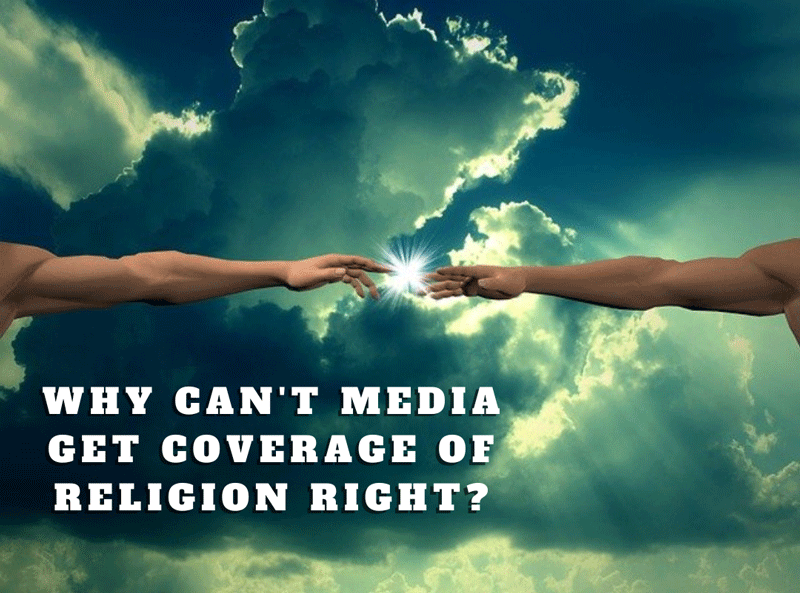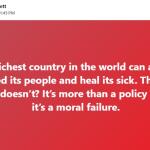
Why can’t the media get coverage of religion right?
There are no easy answers, but neither religious leaders nor journalists are satisfied with current coverage.
That’s one of the major findings of the largest-ever study on media coverage of faith and religion, The Global Faith and Media Study.
It was conducted in August and September. To read the study, click here.
The Faith and Media Initiative commissioned the study, and HarrisX, a market research and consulting company, surveyed more than 9,000 people in 86 countries across the globe. HarrisX also conducted more than 30 in-depth interviews with journalists and editors worldwide.
The initiative brings together faith leaders, members of the media and content creators. Its goals are to “promote more thoughtful, more plentiful faith-related stories that inspire a healthy public conversation about spirituality,” according to its website.
The study revealed that the general public wants more and better coverage of faith and religion, while journalists feel existing coverage is “poor, inconsistent and becoming more marginalized.”
This is a good place to start.
WHAT DO WE MEAN BY “RELIGION”?
When we talk about religion, what do we mean? At least 6 billion people across the world follow a religious tradition, and their beliefs are quite diverse, according to the Pew Research Center.
The word “religion” might refer to Christianity, Islam or Judaism, Buddhism, Hinduism or New Age spirituality, folk religions or any number of other faiths.
Beyond the religious are the non-religious: atheists, who don’t believe in God; agnostics, who doubt we will ever know whether God exists; and people who don’t identify with any particular religion. Even some of these groups are organized.
WORLD FAITH IS COMPLEX
Let’s consider the complexity of just one religion. Christianity remains the world’s largest religion with more than 2 billion members and 40,000+ denominations worldwide, according to the World Atlas.
Christianity has two billion members…. or does it? If you Google “number of Christians worldwide,” you will see what I mean. Some sources put membership at 2.2 billion, while others say 2.3 billion, 2.4 billion, 2.54 billion, 2.6 billion or 2.6+ billion.
Christians’ core belief is the divinity of Jesus Christ, but our beliefs and practices split in numerous directions from there.
- The three major branches of Christianity are Protestant, Catholic and Orthodox.
- Following just one of those branches, Protestantism, we find three major traditions: evangelical, mainline and historically black churches, according to the Pew Research Center.
- Within Protestantism are Baptists, Methodists, Presbyterians, Pentecostals, Anglicans, Episcopalians, Lutherans, Seventh-Day Adventists, Quakers and many, many other denominations.
- Within the denominations, you find Baptists, who may be either evangelical, mainline or historically black; Pentecostals, who are evangelical or historically black; Lutherans, who are evangelical or mainline, etc.
It would be quite easy for a reporter to offend people by misusing words, making assumptions or perpetuating stereotypes.
I’m a cradle Christian, but one of my first mistakes as a journalist occurred in a Christian-related story. It happened when I was a small-town community lifestyles editor.
I interviewed a new Presbyterian minister and wrote a story that referred to his church as a “Presbyterian Church in America” rather than “Presbyterian Church in the United States,” or some such misstatement.
I’m Methodist. I had no idea there were several kinds of Presbyterianism, and I didn’t bother to verify my “facts.” The pastor was gracious, but some of his members were upset. Needless to say, I learned a valuable lesson.
HOW DO PEOPLE DESCRIBE THEIR FAITH?
Let’s go back to the Global Faith and Media Study and see what ordinary people had to say.
- 84% of the global population identified as religious, spiritual or people of faith.
- 74% associated themselves with a specific religion.
- 72% said they believe in God or other deities.
- 31% identified themselves as generally religious.
- 27% considered themselves spiritual.
COVERAGE OF FAITH IS FOUND LACKING
People across the globe want “better coverage, understanding and representation of faith in the media,” the study said.
- 53% of people surveyed said the news media actively ignores religion.
- 59% want the media to cover diverse faith and religious angles.
- 63% demand “high quality content on faith and religion” in their country.
- 61% believe the media perpetuates stereotypes about faith and religion.
- 78% think religious stereotyping should get the same or more attention as race and gender stereotypes.
- 85% want “more diversity and lived experiences from faith representatives.”
THE MEDIA’S POV
Journalists think coverage of faith and religion is inconsistent and becoming more marginalized, according to the faith and media study. They point out several reasons:
- Media professionals don’t see faith and religion as topics that engage readers, and reader engagement is vital to them. Media organizations are businesses, after all, and they rely on readers and advertisers to survive.
- Media professionals don’t think religion is a good fit for the hard news environment except when controversy fuels coverage. They categorize “religion” as soft news if they think about it at all.
- Reduced budgets mean that most media organizations use general assignment reporters rather than religious specialists to cover stories about religion and faith.
- Newsrooms aren’t known for being particularly religious, and journalists and their editors don’t see themselves as experts on faith and religion. Given their lack of expertise, they fear making mistakes in their coverage, and they probably will.
Recent research by McKinsey & Company, a global management consulting firm, supports some of these findings.
The firm asked media leaders at the CEO level to predict the topics that would make headlines across the globe in coming months. The media professionals predicted (in no particular order):
- Climate change
- Big tech
- Fossil fuel shortage
- State of democracy
- Economic effects of COVID-19
- Misinformation
- Artificial intelligence
- Global supply-change challenges
- Crypto
- Labor vs. big business / labor shortage
- Tensions related to China
- Politics and elections
- Income inequality
- Education policy
There was no mention of religion.
WHAT NOW?
Several Patheos contributors have posted stories in response to the faith and media study. Here’s what some have said:
“Once again, it just goes to show that what people want to hear about, and what the media wants to talk about, are often two very different things,” said veteran journalist Kate O’Hare. “Religion is frequently positioned as a conservative or extreme force in coverage, which creates a tendency to seek outspoken dogmatic spokespeople over more middle-ground religious observers with mainstream views.”
“We can surely produce more true interactive conversations in the form of blogs, and many of us could surely cross over into becoming more regular spokespeople and podcast conversation partners,” wrote evangelical faith writer Adrian Warnock, who has had a blog since 2003.
Keith Giles, a former pastor, author and Progressive Christian writer, said he is grateful for The Global Faith and Media Study. “It suggests that we already know we’re being pulled apart by social media, and we’re tired of the ‘Us versus Them’ rhetoric that permeates almost everything we consume….What we need is the opportunity to learn, and that starts by listening to those who may have a new perspective.” See his entire post here.
“With so much religious diversity in the world, it’s important that the news media gets it right,” reminded Nadia Ahmed, whose Patheos blog is “The Mu’mina Lifestyle: Reviving Faith in Muslim Women.” Sensationalism creates stereotypes and negative images, which can cause misunderstandings and hatred among people of different religions, she said. “The media has a responsibility to society and should be mindful of the impact of their words.” See Nadia’s entire post on faith and the media here.
STORIES WAITING TO BE TOLD
That said, in-depth religious stories are out there waiting to be told. One example is recent divisions in the United Methodist Church (UMC). UMC progressives formed the Liberation Methodist Connexion in 2020, while conservatives created the Global Methodist Church earlier this year. Gay issues were the catalyst in both situations.
That’s two major changes in a major, global denomination within two years, and there are multiple points of view and stories that journalists could tell. What specifics issues caused the divisions? Why couldn’t church leaders resolve the problems? What do the splits mean for individual churches and congregations? Is the United Methodist Church collapsing? Are other denominations dealing with similar disagreements?
Other story ideas:
- Interview religious leaders about the relevance or non-relevance of religion in the 21st century and talk about ways religions can make themselves more relevant.
- Ask women about their changing roles in their religious communities.
- Talk to Christian pastors about the decline of Christianity in Europe and the U.S. Why is it declining and what can be done to turn it around?
- Why is Christianity growing so rapidly in Africa? What lessons can Christians elsewhere learn?
- Interview Muslim leaders about challenges they face in the 21st
LET’S JUMPSTART THE CONVERSATION
As a former journalist and brand-new religious blogger, I hope the Global Faith and Media Study helps religious leaders, journalists and editors better understand one another. Most of us want more balanced stories about faith and religion, and the study is a good place to jumpstart the conversation in that direction.












